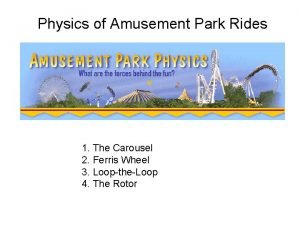Amusement Park Ride Design Stacey Allen th 11

- Slides: 1

Amusement Park Ride Design Stacey Allen th 11 Grade Physics Revere High School To implement various amusement park ride design projects utilizing the EDP throughout our physics curriculum. My students often struggle with the relationships between the concepts, the math, and the real world applications of physics, and I hope that through this series of design projects, they will have the opportunity to consolidate all of this knowledge, while using the EDP to see how a real engineer would design the types of rides that they’ve all seen and experienced. Semester-long 11 th grade physics (mechanics) class at Revere High School, which all students are required to take. Usually classes are around 25 students (± 5). #1: Free Fall Ride (kinematics) • Diagram drawing with measurements and calculations • Full-size decorated poster (2’ x 3’) depicting ride • Completed EDP worksheet #2: Circular Ride (UCM) • Diagram drawing with measurements and calculations • Small-scale model depicting ride • Completed EDP worksheet #3: CAPSTONE – Roller Coaster Design #3: CAPSTONE Roller Coaster Design • Diagram drawing with measurements and calculations • Full-size decorated poster (2’ x 3’) depicting ride • Scaled model built with recyclable materials and k’nex • Power point presentation highlighting safety features and fun-factor (10 min) • Completed EDP worksheet The course will culminate with a capstone roller coaster design project. The other listed projects (#1&2) will be smaller in scale (only posters or basic models) and prepare the students throughout the semester to successfully complete their capstone project with the roller coasters. I hope to also use these smaller projects to acquaint the students with the EDP and practice applying their math skills and conceptual knowledge to real life engineering projects. • EDP worksheet for students to use while completing the process • Intro activities (Roller Coaster Tycoon, online games) • Math & concept outlines related to each design • Rubrics for each deliverable • Appropriate materials for posters and models #1: Free Fall Ride (kinematics) #2: Circular Ride (UCM) What When How First week or two Simple group engineering Introduction of school projects (straw towers, st to EDP (beginning of 1 paper airplanes, etc. ) quarter) Current Status READY After unit on Students will design a ride Kinematics – end incorporating the concepts “Free Fall / Outlined – need of first month of of projectiles and free fall. Projectile” to make student the semester These designs will be poster. Ride Design resources st (end of 1 based only and students will quarter) present their designs. “Circular” Ride Students will design a ride After unit on incorporating the concepts Circular Motion – Outlined – need of circular motion (ex. nd end of 2 month to make student swings, ferris wheel, pirate of semester resources & ship, etc. ). These designs will nd (beginning of 2 gather materials be modeled with simple quarter) prototypes and presented. Need to request Students will follow the EDP materials from to design and build roller $500 NSF grant coasters. They will use During energy unit- completing various materials to design, Appropriate set Capstone – build, and then redesign project up of excel Roller throughout final their prototypes. Students spreadsheets Coaster will need to use all of the month of Design semester (end of concepts they’ve learned in Dates outlined - nd 2 quarter) the course, with a focus on need to make the latest topic (energy student resources conservation). The two smaller ride design projects will take about 2 -3 classes each at the end of the kinematics and circular motion units, respectively. These projects will replace a few smaller activities I previously did at the end of these units. The roller coaster capstone will happen throughout our final unit on energy, and take up significantly more class time. It will replace the time spent on a previous ‘final project’.

